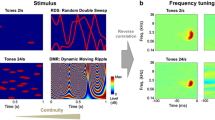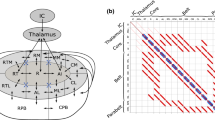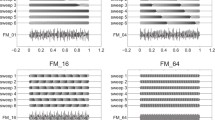Abstract
The brain can be considered a dynamical system which is able to oscillate at multiple frequencies. To study the brain’s preferred oscillation frequencies, the resonance frequencies in the frequency response of the system can be assessed by stimulating the brain at various stimulation frequencies. Furthermore, the event-related potential (ERP) can be considered as the brain’s impulse response. For linear dynamical systems, the frequency response should be equivalent to the frequency transform of the impulse response. The present study test whether this fundamental relation is also true for the frequency transform of the ERP and the frequency response of the brain. Results show that the spectral characteristics of both impulse and frequency response in the gamma frequency range are significantly correlated. Thus, we speculate that the resonance frequencies determine the frequency spectrum of the impulse response. This, in turn, implies that both measures are determined by the same, individually specific, neuronal generator mechanisms.


Similar content being viewed by others
References
Allport GW (1927) Concepts of trait and personality. Psychol Bull 24:284–293
Basar E (1980) EEG-brain dynamics: relation between EEG and brain evoked potentials. Elsevier, Amsterdam
Basar E, Basar-Eroglu C, Karakas S, Schurmann M (2001) Gamma, alpha, delta, and theta oscillations govern cognitive processes. Int J Psychophysiol 39:241–248
Basar-Eroglu C, Basar E, Demiralp T, Schurmann M (1992) P300-response: possible psychophysiological correlates in delta and theta frequency channels. A review. Int J Psychophysiol 13:161–179
Basar-Eroglu C, Struber D, Schurmann M, Stadler M, Basar E (1996) Gamma-band responses in the brain: a short review of psychophysiological correlates and functional significance. Int J Psychophysiol 24:101–112
Bidet-Caulet A, Fischer C, Besle J, Aguera PE, Giard MH, Bertrand O (2007) Effects of selective attention on the electrophysiological representation of concurrent sounds in the human auditory cortex. J Neurosci 27:9252–9261
Borgers C, Epstein S, Kopell NJ (2005) Background gamma rhythmicity and attention in cortical local circuits: a computational study. Proc Natl Acad Sci USA 102:7002–7007
Brenner CA, Sporns O, Lysaker PH, O’Donnell BF (2003) EEG synchronization to modulated auditory tones in schizophrenia, schizoaffective disorder, and schizotypal personality disorder. Am J Psychiatry 160:2238–2240
Brosch M, Budinger E, Scheich H (2002) Stimulus-related gamma oscillations in primate auditory cortex. J Neurophysiol 87:2715–2725
Busch NA, Schadow J, Frund I, Herrmann CS (2006) Time-frequency analysis of target detection reveals an early interface between bottom-up and top-down processes in the gamma-band. Neuroimage 29:1106–1116
Crone NE, Boatman D, Gordon B, Hao L (2001) Induced electrocorticographic gamma activity during auditory perception. Clin Neurophysiol 112:565–582
Debener S, Herrmann CS, Kranczioch C, Gembris D, Engel AK (2003) Top-down attentional processing enhances auditory evoked gamma band activity. Neuroreport 14:683–686
Demiralp T, Basar-Eroglu C, Basar E (1996) Distributed gamma band responses in the brain studied in cortex, reticular formation, hippocampus and cerebellum. Int J Neurosci 84:1–13
Di Russo F, Pitzalis S, Aprile T, Spitoni G, Patria F, Stella A, Spinelli D, Hillyard SA (2007) Spatiotemporal analysis of the cortical sources of the steady-state visual evoked potential. Hum Brain Mapp 28:323–334
Draganova R, Ross B, Wollbrink A, Pantev C (2008) Cortical steady-state responses to central and peripheral auditory beats. Cereb Cortex 18:1193–1200
Fedotchev AI, Bondar AT, Konovalov VF (1990) Stability of resonance EEG reactions to flickering light in humans. Int J Psychophysiol 9:189–193
Freeman WJ (1975) Mass action in the nervous system. Academic Press, New York
Fries P, Reynolds JH, Rorie AE, Desimone R (2001) Modulation of oscillatory neuronal synchronization by selective visual attention. Science 291:1560–1563
Frund I, Schadow J, Busch NA, Korner U, Herrmann CS (2007) Evoked gamma oscillations in human scalp EEG are test-retest reliable. Clin Neurophysiol 118:221–227
Galambos R, Makeig S, Talmachoff PJ (1981) A 40-Hz auditory potential recorded from the human scalp. Proc Natl Acad Sci USA 78:2643–2647
Gutschalk A, Mase R, Roth R, Ille N, Rupp A, Hahnel S, Picton TW, Scherg M (1999) Deconvolution of 40 Hz steady-state fields reveals two overlapping source activities of the human auditory cortex. Clin Neurophysiol 110:856–868
Herrmann CS (2001) Human EEG responses to 1–100 Hz flicker: resonance phenomena in visual cortex and their potential correlation to cognitive phenomena. Exp Brain Res 137:346–353
Herrmann CS, Mecklinger A, Pfeifer E (1999) Gamma responses and ERPs in a visual classification task. Clin Neurophysiol 110:636–642
Herrmann CS, Frund I, Lenz D (2010) Human gamma-band activity: a review on cognitive and behavioral correlates and network models. Neurosci Biobehav Rev 34:981–992. doi:10.1016/j.neubiorev.2009.09.001
Hutcheon B, Yarom Y (2000) Resonance, oscillation and the intrinsic frequency preferences of neurons. Trends Neurosci 23:216–222
Izhikevich EM, Desai NS, Walcott EC, Hoppensteadt FC (2003) Bursts as a unit of neural information: selective communication via resonance. Trends Neurosci 26:161–167
Kaiser J, Lutzenberger W (2003) Induced gamma-band activity and human brain function. Neuroscientist 9:475–484
Kaiser J, Heidegger T, Lutzenberger W (2008) Behavioral relevance of gamma-band activity for short-term memory-based auditory decision-making. Eur J Neurosci 27:3322–3328
Kaiser J, Lutzenberger W, Decker C, Wibral M, Rahm B (2009) Task- and performance-related modulation of domain-specific auditory short-term memory representations in the gamma-band. Neuroimage 46:1127–1136
Krishnan GP, Hetrick WP, Brenner CA, Shekhar A, Steffen AN, O’Donnell BF (2009) Steady state and induced auditory gamma deficits in schizophrenia. Neuroimage 47:1711–1719
Kwon JS, O’Donnell BF, Wallenstein GV, Greene RW, Hirayasu Y et al (1999) Gamma frequency-range abnormalities to auditory stimulation in schizophrenia. Arch Gen Psychiatry 56:1001–1005
Llinas RR (1988) The intrinsic electrophysiological properties of mammalian neurons: insights into central nervous system function. Science 242:1654–1664
Oppenheim AV, Schafer RW, Buck JR (1999) Discrete-time signal processing. Prentice Hall, Upper Saddle River
Pantev C, Roberts LE, Elbert T, Ross B, Wienbruch C (1996) Tonotopic organization of the sources of human auditory steady-state responses. Hear Res 101:62–74
Pastor MA, Artieda J, Arbizu J, Valencia M, Masdeu JC (2003) Human cerebral activation during steady-state visual-evoked responses. J Neurosci 23:11621–11627
Rols G, Tallon-Baudry C, Girard P, Bertrand O, Bullier J (2001) Cortical mapping of gamma oscillations in areas V1 and V4 of the macaque monkey. Vis Neurosci 18:527–540
Ross B, Picton TW, Herdman AT, Pantev C (2004) The effect of attention on the auditory steady-state response. Neurol Clin Neurophysiol 2004:22
Schadow J, Lenz D, Dettler N, Frund I, Herrmann CS (2009) Early gamma-band responses reflect anticipatory top-down modulation in the auditory cortex. Neuroimage 15:651–658
Strogatz S (2003) Sync. The emerging science of spontaneous order. Hyperion, New York
Tallon-Baudry C, Bertrand O, Henaff MA, Isnard J, Fischer C (2005) Attention modulates gamma-band oscillations differently in the human lateral occipital cortex and fusiform gyrus. Cereb Cortex 15:654–662
Tiesinga PH, Fellous JM, Jose JV, Sejnowski TJ (2001) Computational model of carbachol-induced delta, theta, and gamma oscillations in the hippocampus. Hippocampus 11:251–274
Traub RD, Jefferys JGR, Whittington MA (1997) Simulation of gamma rhythms in networks of interneurons and pyramidal cells. J Comput Neurosci 4:141–150
Vida I, Bartos M, Jonas P (2006) Shunting inhibition improves robustness of gamma oscillations in hippocampal interneuron networks by homogenizing firing rates. Neuron 49:107–117
Walter VJ, Walter WG (1949) The central effects of rhythmic sensory stimulation. Electroencephalogr Clin Neurophysiol 1:57–86
Weisz N, Keil A, Wienbruch C, Hoffmeister S, Elbert T (2004) One set of sounds, two tonotopic maps: exploring auditory cortex with amplitude-modulated tones. Clin Neurophysiol 115:1249–1258
Whittington MA, Traub RD, Kopell N, Ermentrout B, Buhl EH (2000) Inhibition-based rhythms: experimental and mathematical observations on network dynamics. Int J Psychophysiol 38:315–336
Wienbruch C, Paul I, Weisz N, Elbert T, Roberts LE (2006) Frequency organization of the 40-Hz auditory steady-state response in normal hearing and in tinnitus. Neuroimage 33:180–194
Zaehle T, Frund I, Schadow J, Tharig S, Schoenfeld MA, Herrmann CS (2009) Inter- and intra-individual covariations of hemodynamic and oscillatory gamma responses in the human cortex. Front Hum Neurosci 3:8
Acknowledgments
This study was supported by the Deutsche Forschungsgemeinschaft (SFB/TRR31-TPA9) and the State of Saxony-Anhalt (excellence cluster C3).
Author information
Authors and Affiliations
Corresponding author
Rights and permissions
About this article
Cite this article
Zaehle, T., Lenz, D., Ohl, F.W. et al. Resonance phenomena in the human auditory cortex: individual resonance frequencies of the cerebral cortex determine electrophysiological responses. Exp Brain Res 203, 629–635 (2010). https://doi.org/10.1007/s00221-010-2265-8
Received:
Accepted:
Published:
Issue Date:
DOI: https://doi.org/10.1007/s00221-010-2265-8




